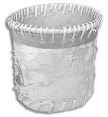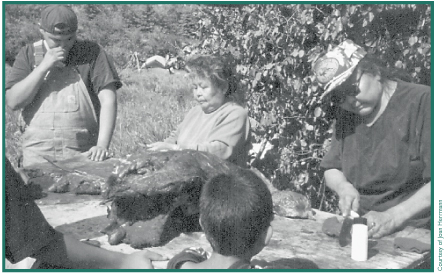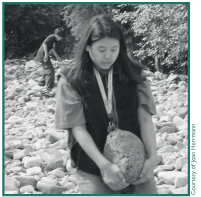|
|
|
 WHOUY SZE KUINALTH WHOUY SZE KUINALTH
"Teaching Our Many Grandchildren"
uts'e' Kat'aen
Keeping (Ourselves) Healthy
|
STATE STANDARDS
English/Language Arts
B. A student should be a competent and thoughtful reader, listener
and viewer of literature, technical materials, and a variety of other
information.
E. A student should understand and respect the perspectives of others
in order to communicate effectively.
Science
A. A student should understand scientific facts, concepts, principals
and theories.
B. A student should possess and understand the skills of scientific
inquiry.
History
A. A student should understand that history is a record of human experiences
that links the past to the present and the future.
C. A student should develop the skills and processes of historical
inquiry.
Skills For A Healthy Lifestyle
A. A student should be able to acquire a core knowledge related to
well-being.
B. A student should be able to demonstrate responsibility for the
student's well-being.
C. A student should understand how well-being is affected by relationships
with others.
World Languages
B. A student should expand the student's knowledge of peoples and
cultures through language study.
CULTURAL STANDARDS
A. Culturally-knowledgeable students are well grounded in the cultural
heritage and traditions of their community.
C. Culturally-knowledgeable students are able to actively participate
in various cultural environments.
D. Culturally-knowledgeable students are able to engage effectively
in learning activities that are based on traditional ways of knowing
and learning.
E. Culturally-knowledgeable students demonstrate an awareness and
appreciation of the relationships and processes of interaction of all
elements in the world around them.
|

Amber Koso, Chistochina.
|
OBJECTIVES
Students will:
- interact with Elders and knowledgeable community members
to gain culturally relevant and current life skills for staying
healthy.
- develop language skills.
- explore what health is and what it means to be healthy.
- explore community interactions and development of values
through discussion.
- learn about the proper ways to prepare and use the steambath.
- learn how to gather and prepare local plants and food.
|
|
|
Lesson
GRADES K -12
The communities of Chistochina and Mentasta are Ahtna Athabascan,
or Dene people, rooted in thousands of years of tradition, family,
and cooperation. For classroom discussion, we need to simplify the
complex system of our culture and language in order to lay a foundation
for discussion about life ways, values and community. We live by "Indian
laws" that we are taught through practice and discipline as children.
From these laws, and within the context of life, we draw values. From
these values, we individually form our character. As mentioned in the
previous chapter, each person has a different role in the communities.
It is by the character of each person that they find or are given their
roles. Wilson Justin said it in this way: " Life's first duty is to
your heart. Be true to yourself. You can be true to yourself without
being untrue to others." Respect for self, first and through this,
respect for everything.
In order to begin the following lessons, invite members of the community
into the classroom to discuss these lifeskills and to inspire the students
to talk about what they know and value.
The following list of values was compiled by the focus groups of Mentasta
and Chistochina. These values should help get the discussion started,
but should not replace further discussion about Indian Laws, values,
and character.
|
 Teacher
Note: Teacher
Note:
The knowledge of how some plants are used is sacred to many Alaska
Native people and may not be readily available. It is important to
work with the Tribal Council before approaching an Elder for this
knowledge. The underlying principal of our belief system is "heal
the person and never have to heal them again".
Encourage the students to use the language for the plants, the
steambath, the rocks, values, etc. They can include the words in
journals, posters, drawings and any other project they complete.
Diabetes is a disease that effects all ages. It occurs when the
body is unable to metabolize all of the blood sugar from the carbohydrates
in the foods that we eat. Diet and exercise play an important part
in preventing diabetes. People with diabetes are not able to produce
enough insulin and/or use insulin properly that their body does produce.
Without proper insulin levels in the blood, high sugar levels become
harmful to all tissues. This can lead to serious medical problems
including kidney damage, amputations, and blindness. Diabetes is
also closely linked to heart disease. High blood sugar can be lowered
by diet and exercise, by a number of oral medications or by insulin
injections. Obesity is a main factor that has been shown to cause
diabetes.
|

Activities:
-
Grades K-4 Guide the students in a discussion about
things that they do that make them feel good. What makes
a healthy person? What makes you feel healthy? What do
you eat that makes you feel healthy? For example: playing,
sleeping, friendships, living in a good place, not being
sick, family and loved ones, learning new things, music,
dance, respect for people, land, water and animals.
-
Grades 5-12 Lead a discussion exploring the ideas of
everyday health and long-term health. What makes a healthy
person? What makes you feel healthy? Include in the discussion
elements of health including values and traditions, spirituality,
land, water, food, a safe home, physical activity, an
active mind, events in the community, good relationships,
music, dance, singing, language, culture, respect, sleep,
and illness.
-
The following activities are broken into elements of
healthy living. It is important to note that they are
not independent of one another, but are very much interdependent
in order to make up a healthy person. Students should
explore how or why a healthy person has a balance of
all of these elements.
Chester Pence and others watch
as Ruby Sinyon and Molly Galbreath, butcher a moose.

Courtesy of
Joan Herrmann
|
Gigi, ts'abaeli, c'et'aan'
Berries, trees,
plants:
A. Gather plants with an Elder or community
member. Have the students prepare for this outing
by brainstorming what they already know. What plants
are they familiar with? What plants are used for
various activities in the community? For example,
blueberries are picked every fall and are stored
for the winter. Spruce roots are used for making
baskets and the logs are used for building homes
and structures.
B. Which plants were used for staying
healthy? Berries provide an important source of
vitamins and minerals (especially vitamin c). Other
plants are used for sanitizing wounds, drawing
out infection and treating burns. Have the students
record what they learned from talking to and walking
with an Elder in a journal entry, story, plant
press or picture diagram. Have the students make
thank-you cards for their Elders using pressed
plants or hand-drawn plant pictures including information
they learned.
C. What plants were used to help keep
people healthy in the past? Add the answers to
the calendar the class created in the previous
chapter.
i'yaal
Rigorous
Activity:
A. Ask the students to make a list of all the
physical activities they do every day. What did
their Elders do when they were growing up? Have
them list what the Elders tell them. Guide the
students to design a relay race of activities Elders
did daily (in different seasons) when they were
the age of the students. Why was it important to
stay active? Why is it important to stay active?
How does it help you feel good about yourself (mentally,
physically and emotionally)?
B. Guide the students to brainstorm healthy activities
and events that they could be part of in their
community. Is there an activity that they would
like to make into a community event?
K'aa Al ten Niits' iilean
Gathering
Our Food:
A. How do values effect your actions while hunting
and harvesting food? Are there certain ethics that
you need to abide by? Why are these important?
What does it mean to "give respect" to the land,
water and food?
B. How do you learn about the values used during
harvesting food? How might they help you stay healthy?
C. What do the Elders mean when they say to keep
quiet when hunting? Why is it important to show
respect for our food?
Sezel
Steambath:
A. What is the meaning of "steambath"? How is
it prepared and how does it keep a person healthy?
B. Interview an Elder or community member about
preparing a steambath. How is it prepared?
C. Take a field trip to a steambath to have students
learn about building the fire, choosing the rocks
and setting up the structure. Which plants are
used? How are they harvested and prepared? How
do they help a person to stay healthy?
|

Courtesy
of Joan Herrmann
Molly Galbreath
teaches how to set snares.
FURTHER RESOURCES FOR
RESEARCH AND ACTIVITIES
Alaska Native Knowledge Network
ankn.uaf.edu/
Subsistence board game and curriculum
Alaska Rural Systemic Initiative
South Central Foundation
http://www.southcentralfoundation.org/
Alaska Native Health Board www.anhb.org
Association of American Indian Physicians
www.aaip.org
FOR FURTHER INFORMATION
AND
CURRICULUM RESOURCES ON PLANTS:
Mathews,Donna. Unangam
Hitnisanginl Unangam Hitnisangisl Aleut A
Region-Based Plant Curriculum for Grades
4-6. Pilot Edition.
Alaska Native Knowledge Network
Institute of Social and Economic Research
University of Alaska Anchorage, 3211
Providence Drive, Anchorage, AK 99508
Kawagley, A. Oscar 1995. A Yupiaq Worldview
A Pathway To Ecology and Spirit. Prospect
Heights, Illinois:Waveland Press
MORE INFORMATION
ABOUT THE AHTNA LANGUAGE
Kari, James. 1990. Ahtna Athabaskan Dictionary
Alaska Native Language Center University of Alaska
Fairbanks, Alaska. Ahtna, Inc. Glennallen, AK.
|
Christine Bernsten gathers
steambath rocks near Nabesna.

Courtesy of Joan Herrmann
Marilynn Beeter and Lena Charley.

©Bill Hess
|
Values:
Review local traditional values by interviewing
Tribal members about the following concepts:
A. Discuss the meaning of responsibility to self
and to others. How do these responsibilities change
as you get older?
B. Discuss the meaning of respect for land,water,
food, animals, people and self.
C. Grades 5-12 Discuss traditional spirituality.
How does spirituality affect the community value
system? Have the students heard a story that helps
them/helped them to understand their cultural spirituality?
Ts'ax (illness, sick)
Illnesses
of Today
A. Research some of the ways people are sick today.
Discuss what might make people sick. What can they
do to stay healthy?
B. Have the students talk to a health aide or
local health practitioner about some of the current
illnesses and diseases that affect people in your
community. Some of these may include cancer, diabetes,
drug abuse and heart disease. What are some of
the possible causes of these diseases? What are
some of the solutions and treatments to them? (Habits,
values, traditions, diet, education, etc.) How
can the students help the community prevent these
diseases?
Discussion Ideas:
- What are your community's values as they pertain
to a healthy lifestyle? How do these help our
health? Have the students write or voice important
community values.
- Have some traditional health practices changed?
If so, how has some knowledge about plant uses
been lost? Could your community rely on local
plants for their health needs? What are the present
illnesses that may not be able to be treated
with plants?
- How might our values and traditions help us
make healthy choices?
- What are the affects of watching videos and
TV? What are the affects of not spending time
outside? What are the affects of not spending
time with our families, aunts, uncles and grandparents?
Ask the students to discuss this question with
their families.
|
|
 The
University of Alaska Fairbanks is an Affirmative
Action/Equal Opportunity employer, educational
institution, and provider is a part of the University of Alaska
system. Learn more about UA's notice of nondiscrimination. The
University of Alaska Fairbanks is an Affirmative
Action/Equal Opportunity employer, educational
institution, and provider is a part of the University of Alaska
system. Learn more about UA's notice of nondiscrimination.
Alaska Native Knowledge
Network
University of Alaska Fairbanks
PO Box 756730
Fairbanks AK 99775-6730
Phone (907) 474.1902
Fax (907) 474.1957 |
Questions or comments?
Contact ANKN |
|
Last
modified
August 17, 2006
|
|
|